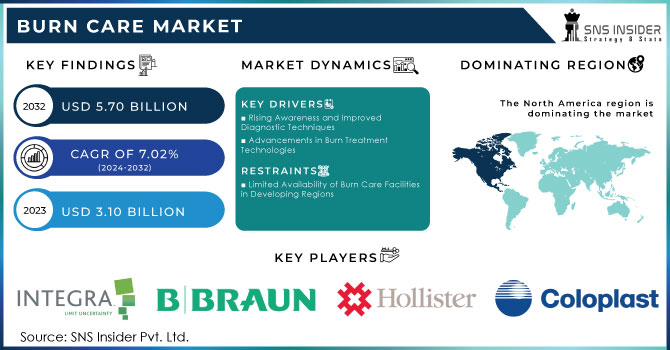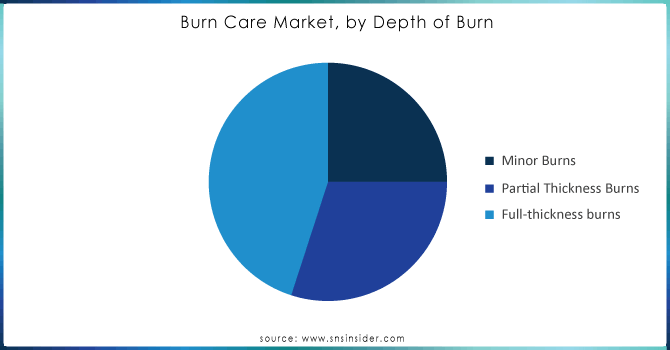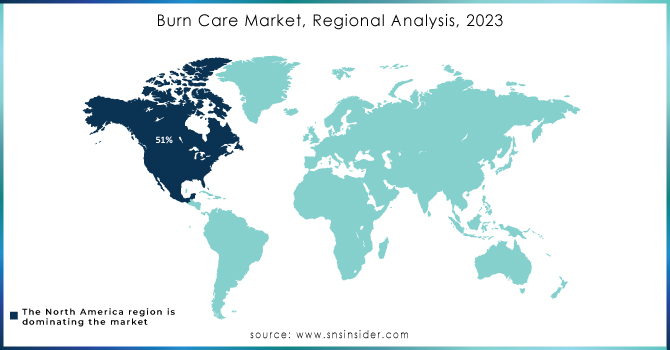Burn Care Market Report Scope & Overview:

Get More Information on Burn Care Market - Request Sample Report
The Burn Care Market size was valued at USD 3.10 Billion in 2023. It is estimated to reach USD 5.70 Billion by 2032, growing at a CAGR of 7.02% during 2024-2032.
The burn care market is a dynamic sector within healthcare, driven by advancements in medical technology and an increasing awareness of effective treatment options for burn injuries. In 2023, there was a significant number of burn-related deaths in the United States, with around 3,500 to 4,000 fatalities recorded. This data, collected from the NFPA and other pertinent sources, showcases progress as well as ongoing obstacles in fire safety and burn prevention. The American Burn Association (ABA) approximated that about 500,000 people received medical care for burn injuries in the year. Fire departments from all over the nation attended to more than 1.3 million fires, many of which resulted in burn injuries, adding to the total number of deaths for the year. Data on demographics shows that older adults and young children are disproportionately impacted by burn fatalities. Around 30% of the deaths occurred in people aged 65 and over, with 10% affecting children under 5 years old. Moreover, a higher number of men were impacted, representing around 60% of all fatalities resulting from burns. Advanced wound care dressings, including hydrogels, hydrocolloids, and foam dressings, play a crucial role in protecting burns from infection and promoting healing. Topical agents, such as silver sulfadiazine and antimicrobial ointments, help prevent bacterial infections and reduce inflammation. In cases of severe burns, skin grafts, and artificial skin products are essential for covering the burn area and facilitating skin regeneration.
Technological innovations in the market are focused on enhancing patient outcomes. For example, bioengineered skin replacements and advanced regenerative treatments have greatly improved the care of severe and widespread burns. These advancements aim to speed up the healing process, decrease the chances of complications, and lessen the necessity for additional surgeries. Additionally, the incorporation of digital health technology, including telemedicine and burn care applications, is revolutionizing patient care through offering remote consultations and monitoring. Demographic factors also play a role in shaping the burn care market. The rise in demand for burn care solutions is anticipated due to an aging population and an increase in chronic diseases like diabetes affecting skin integrity. Furthermore, the increasing occurrence of burns caused by trauma, accidents, and natural disasters underlines the importance of implementing successful burn treatment strategies.
Market Dynamics
Drivers
-
Rising Awareness and Improved Diagnostic Techniques
The burn care market is driven by both increased public awareness of preventing and treating burns and improvements in diagnostic techniques. In other words, public awareness and diagnostic improvements are interrelated, but both are important for the development of the market. On the one hand, the increased attention of the general public to burn safety and first aid helps in the early discovery of a burn. Fixed first-aid rules and multiple public awareness campaigns allow educative large masses of people. On the other hand, diagnostic achievements, such as high-resolution imaging and specialized burn assessment tools, make it possible to differentiate between types of burns, evaluate the severity of the injury, and develop a precise treatment plan. Together, public awareness and diagnostic achievements spread knowledge and products necessary for burn management. Over time, the development of both elements leads to higher demand for burn care products.
-
Advancements in Burn Treatment Technologies
Burn care advancements that have occurred in recent years have greatly affected the development of the disease among patients and the speed of recovery. Bioengineered skin covers, advanced wound dressings, and automated systems of treatment delivery have changed the whole process of managing burns. Bioengineered skin, such as cultured epidermal autografts, is beneficial for healing as it serves as a protectant and promotes faster cell growth. Advanced wound dressings, such as hydrocolloids and alginates, create moist environments for quick pain relief and decreased risk for infections. The systems for burn treatment automate the process of applying produced solutions with equal intervals and sectioning, thus, minimizing risks for patient complications and discomfort. Technological progress affects the sphere of burn care as well by introducing new solutions to the existing types of this condition. The technologies advanced in patient treatment and became more integrated into burning care practices, enhancing the efficiency and safety of the offered solutions.
Restraints
-
Limited Availability of Burn Care Facilities in Developing Regions
The burn care market poses significant challenges since there is an increasing need to reshape and expand the existing infrastructure of burn care facilities and centers which are often absent in many developing regions. The lack of burn facilities therein contributes to the problem of the medical services sector developing differentiation in different regions. The burn care service should be differentiated from those provided in other spheres. The quality of services is also contributory to the burden in developing regions. The high rate of inter-region disproportion poses additional difficulties. Since overburden can contribute to the creation of new territories, not all patients can be admitted in developed regions.
Market Segmentation
By Product
Advanced Dressings held more than 44% market share in 2023 because of their exceptional efficacy and quick uptake. These items are created to speed up the healing process of wounds and lower the chance of infection, unlike conventional techniques. More advanced types of dressings such as hydrocolloids, hydrogels, and foam dressings create a wet healing environment and are commonly mixed with antimicrobial substances to avoid infections. They also provide increased comfort and easier application, enhancing patient results and decreasing total treatment time. Prominent firms in this sector, like Smith & Nephew, provide a variety of innovative wound care items like AquaGuard and OpSite brands.
The biologics segment is expected to have a faster CAGR during 2024-2032. Biologics consist of items such as skin grafts, cultured epithelial autografts, and cellular therapies that stimulate tissue regeneration and healing on a cellular scale. They are especially beneficial for severe burn cases where conventional methods may be insufficient. Biologics provide major advantages by speeding up healing, minimizing scarring, and enhancing functional results. Organogenesis provides Apligraf, a bioengineered treatment utilizing living cells to speed up the healing process of wounds. Ongoing research and technological advancements are driving the growth of biologics, making them a forefront option in burn care.
By Depth of Burn
Full-thickness burns led the market with a 45% market share in 2023. These serious burns usually need surgical procedures like skin grafting to help with healing and regain functionality. The strong presence of this sector in the burn care industry is due to the intricate nature and increased expenses of treating full-thickness burns. This section contains items like high-tech wound dressings, skin replacements, and special burn care kits created for critical care environments. Integra LifeSciences provides cutting-edge burn care solutions such as the Integra Dermal Regeneration Template, aiding tissue regeneration in full-thickness burn injuries. This product showcases the industry's dedication to tackling the challenges of full-thickness burns using advanced technologies.
Partial thickness burns are growing at a faster rate during the forecast period. These burns result in redness, inflammation, and blistering, and are more agonizing than minor burns. Partial-thickness burns are a notable part of the Burn Care Market because they are more severe and demand more treatment than minor burns. The sector is growing due to increased knowledge and developments in burn treatment. For instance, Smith & Nephew offers innovative wound healing products like hydrogel dressings and antimicrobial dressings for treating partial-thickness burns. The rising number of burn injuries in both industrial and domestic settings is fueling the need for more advanced partial-thickness burn treatment options.

Need any customization research on Burn Care Market - Enquiry Now
Regional Analysis
North America dominated the market with 51% in 2023 with its advanced healthcare system, high medical spending, and substantial investment in burn care research and technology. Having top-tier facilities like Shriners Hospitals for Children and U.S. Burn Centers in the area enhances its standing. Furthermore, the quick uptake of new technologies and products such as cutting-edge wound dressings and skin grafts drives expansion. MediWound Ltd. and Integra LifeSciences have made significant advances in the U.S. market with their innovative burn treatment options, such as enzymatic debris and bioengineered skin replacements.
The Asia-Pacific region is accounted to have a faster CAGR during 2024-2032, due to a rise in burn injuries, increased healthcare awareness, and improved healthcare infrastructure. Nations such as China and India are seeing substantial growth because of their large populations and rising investments in healthcare. For example, Johnson & Johnson and Burns & Scalds Research Ltd. have been increasing their influence in the area by offering specialized burn care products and services that cater to the specific requirements of the community. The increase in economic development and availability of advanced treatment options is speeding up the expansion of the burn care market in this area.

Key Players
The key players in the Burn Care market are Hollister Incorporated, B. Braun Melsungen AG, Derma Sciences, Acelity, KCI Medical, 3M, Hollister Incorporated, Cardinal Health, Integra LifeSciences Corporation, Coloplast Corp., DeRoyal Industries, Inc., Smith & Nephew, ConvaTec Inc., Molnlycke Health Care AB., Johnson & Johnson, and others.
Recent Development
-
March 2024: MediWound announced the launch of NexoBrid®, a new enzymatic debridement agent designed to remove eschar and necrotic tissue in burn wounds. The product is expected to improve healing times and reduce the need for surgical debridement.
-
February 2024: Mylan introduced a new over-the-counter burn relief spray that contains lidocaine for pain relief and aloe vera for soothing. This product is aimed at providing quick relief and protection for minor burns.
-
January 2024: Smith & Nephew launched AquaCell® Burn, a new advanced burn dressing that utilizes hydrogel technology to maintain a moist wound environment and promote faster healing.
| Report Attributes | Details |
|---|---|
| Market Size in 2023 | USD 3.10 Billion |
| Market Size by 2032 | USD 5.70 Billion |
| CAGR | CAGR of 7.02% From 2024 to 2032 |
| Base Year | 2023 |
| Forecast Period | 2024-2032 |
| Historical Data | 2020-2022 |
| Report Scope & Coverage | Market Size, Segments Analysis, Competitive Landscape, Regional Analysis, DROC & SWOT Analysis, Forecast Outlook |
| Key Segments | • By Product (Advanced dressing, Biologics, Traditional Burn Care Products, Others) • By Depth of Burn (Minor Burns, Partial Thickness Burns, Full-Thickness Burns) • By Cause of Burn (Thermal Burns, Electrical Burns, Chemical Burns, Others) • By End User (Hospitals, Outpatient Facilities, Home Care, Others) |
| Regional Analysis/Coverage | North America (US, Canada, Mexico), Europe (Eastern Europe [Poland, Romania, Hungary, Turkey, Rest of Eastern Europe] Western Europe] Germany, France, UK, Italy, Spain, Netherlands, Switzerland, Austria, Rest of Western Europe]), Asia Pacific (China, India, Japan, South Korea, Vietnam, Singapore, Australia, Rest of Asia Pacific), Middle East & Africa (Middle East [UAE, Egypt, Saudi Arabia, Qatar, Rest of Middle East], Africa [Nigeria, South Africa, Rest of Africa], Latin America (Brazil, Argentina, Colombia, Rest of Latin America) |
| Company Profiles | Hollister Incorporated, B. Braun Melsungen AG, Derma Sciences, Acelity, KCI Medical, 3M, Hollister Incorporated, Cardinal Health, Integra LifeSciences Corporation, Coloplast Corp., DeRoyal Industries, Inc., Smith & Nephew, ConvaTec Inc., Molnlycke Health Care AB., Johnson & Johnson |
| Key Drivers | • Rising Awareness and Improved Diagnostic Techniques • Advancements in Burn Treatment Technologies |
| RESTRAINTS | • Limited Availability of Burn Care Facilities in Developing Regions |

